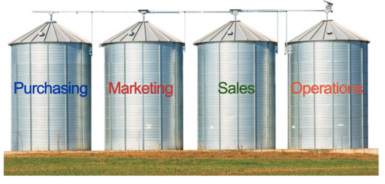The web fuels your company with the timely information and business intelligence you need to stay competitive.
When are our estimated quarterly taxes due this year? How will the new privacy regulations affect how we interact with customers? Which software is the best fit for our exact needs and budget? In which social media groups does our target market engage?
It seems there’s no question too complex for a simple web search.
As powerful as the Internet can be for your business, it’s also a vast and ever-growing ecosystem. With billions and billions of web pages to sift through, there’s clearly more information than you could ever consume.
Luckily, Insightly can help you make better sense of it all. In this post, I’ll share a few tips for converting Insightly into a personal Internet for your business.
Problem: Your Information is Everywhere
At a very basic level, the Internet is nothing more than a collection of linked-together files. Some files are made available as plain text articles with embedded images (such as the blog post that you’re reading!) while others offer more of a multi-media experience (such as videos). Regardless of a file’s format, most publishers aim to provide web content that is helpful, informative, and easily accessible.
Looking at your business, you likely come into contact with dozens of “helpful and informative” pieces of information each day. For example, that 12-page blog article about SEO that your marketing intern sent you can easily be bookmarked for later. Unfortunately, there’s not an easy way to “bookmark” things like:
- A spreadsheet containing the names and contact details for your top 100 leads (ranked in order of importance)
- A PDF report from your accountant, comparing different profitability scenarios
- An email from your recruiter, explaining her top three candidates for your sales department
- A private Google Docs file, containing your company’s strategy roadmap (prepared by your business development consultant)
- Three recent invoices from a vendor who might be ripping you off
- A project plan, containing detailed milestones and tasks for various staff members
- Email marketing campaign data from your most recent newsletter
So, how do you deal with things like this? If you’re like most business owners, you probably try to use some combination of inbox labels and cloud or desktop folders. Trouble is, things frequently get lost – and, perhaps even worse, there’s no guarantee you’ll ever remember to follow up.
Aggregate the Information that Matters to You
A platform like Insightly solves this problem by getting your most important information into a usable, consistent format in a single location. Instead of spreading your files across multiple locations (which aren’t connected, by the way), Insightly becomes your one-stop location for business intel – accessible from any web-enabled device. In other words, Insightly becomes your own personal Internet.
With that being said, let’s see how Insightly can solve the challenges mentioned above. (In the interest of brevity, I’ll focus on just a few of the examples that we’ve discussed.)
Spreadsheet with Your Top 100 Leads:
At its core, Insightly is a CRM (customer relationship management) system. Therefore, if you’re using it correctly, your team won’t need to waste time creating lead tracking spreadsheets. Since your leads are already in Insightly, your team should instead just use the “lead rating” field to group important prospects in order. Or, you could always create a custom field to get a pure 1-to-100 sequenced list. Either way, all of this should be done within your Insightly account – not spreadsheets.

PDF from Your Accountant:
Your CPA’s time isn’t cheap. You’ll therefore want to make the most of his or her efforts. In the past, reports like this have sat in your inbox for weeks. Why not forward that email (attachments and all) to an accounting-related Insightly project? In doing so, you’ll get it out of your inbox and into a more action-friendly format. Insightly does the filing and admin work for you, saving a copy of the email and PDF exactly where you need it. For added firepower, consider enabling an automated workflow, ensuring that you’ll actually do something with it in the future.

Private Google Docs File:
Insightly connects to dozens of cloud-based apps that you’re already using, including several document management platforms. So, rather than sharing the doc via email, Insightly lets you “attach” cloud documents to any lead, contact, organization, opportunity, lead, or project record. Just connect Insightly to your document management tool, and you’re good to go.

No more hunting through dozens of online folders or email threads. The info you need is neatly linked to the correct records in Insightly.
Project Plan with Milestone Data:
One of the best-kept secrets among Insightly users is the tool’s native project management capabilities. Insightly is actually much more than a CRM; it’s built to support every step of the customer journey – from lead cultivation through delivery. So, if your team is using an external project tracking tool, your company might be missing out on a golden opportunity to boost efficiency. Insightly collects all of your project-related documentation, project plans, worksheets, and tasks into a centralized hub. Track milestones and project pipelines with much less effort (and confusion).
Build an In-House Search Engine
With everything stored securely in Insightly, now the fun can really begin. Insightly indexes your information, making it searchable by you and your staff. In other words, Insightly serves as an in-house search engine for your business.
Stop and think about the potential impact this could have on your business. Instead of searching one database for an email address and your computer’s folders for a related file, Insightly allows you to search across all record and file types simply by keying in a few words.
Searching in Insightly will return (in real time) any potential matches within your:
- Contacts
- Leads
- Opportunities
- Organizations
- Projects
- Files
- Notes
- Comments
- Tasks
- Events
With so many potential matches, however, you might be asking yourself, “How does Insightly decide which records to show first?” The software’s search algorithm takes into consideration a number of factors and logic, returning the records that you’re most likely looking for. For example, if you’re looking for a first and last name, Insightly will rank an exact contact name higher than matches found in notes or comments.

Sometimes, you know exactly what type of information you’re looking for. Doing too broad of a search might be more of a distraction than help. For example, I’m sure that you’ve used a Google images filter to identify a particular graphic or photo. The same can be done in Insightly, thanks to the tool’s intuitive search filter. Remember that project you created to forward reports from your CPA? To search for it, just key in the letters “CPA,” and click the “Projects” tab. Voila! All of your accountant’s valuable insights are now accessible at your fingertips.

As with any other search engine optimization strategy, manually creating “links” between your content is always a smart decision. Insightly makes is easy to link records together, saving your team time and effort. Better yet, Insightly even lets you track why a link exists – such as how one person knows the other.
![]()
And, as relationships and circumstances change, you can always edit or remove a link altogether…no IT help required!
Make the Most of Your In-House Knowledge
With a centralized, robust search engine of business intelligence at your disposal, your team will be primed for new levels of efficiency. To maximize the value of this asset, however, be sure to develop an ongoing strategy for keeping things fresh. After all, the world wide web wasn’t built in a single day. Nor did it stop expanding at a certain date in time. The Internet is always growing, always changing. Likewise, your Insightly knowledge base should always be evolving. Gaining buy-in from staff is an important step for building the best version of your in-house search engine.
One final note: It’s likely that some of your team members will be resistant to change. That’s OK, as you’re in this for the long haul. Create detailed work instructions and training videos, explaining how you expect the system to be utilized. Track which team members are the most active, and which team members aren’t holding up their end of the deal. In time, your staff will find that having a “micro Internet” actually helps them complete more tasks, access more reliable information, and achieve more goals.
After all, who doesn’t like to have everything accessible with a simple web search? I sure do.

Matt Keener is a marketing consultant and President of Keener Marketing Solutions, LLC. Matt specializes in content marketing and strategic planning, having helped numerous Saas (software as a service) companies and other small businesses worldwide. Read more of Matt’s work, get his book, or connect on LinkedIn.




